| |
'A dedicated, painstaking craftsman, Don was maniacal in his continuing battle against stupid studio authority. He was and is constantly amazed at the idiocy of our industry, while still being delighted by its competence and professionalism. I realised that I might be considered in the latter category when, upon seeing one of my earlier TV shows, he turned away muttering, “You’re not that good!”' |
| |
Director Sam Pekinpah* |
I hold the original 1956 Don Siegel directed Invasion of the Body Snatchers in the highest regard and I’m going to use this review to dig a little deeper to find out why. Hollywood was in love with science fiction in the fifties. Cinemas were full of beasts from God knows how many fathoms (where presumably they would be crushed to death by the pressure or explode upon exiting the depths – short movie methinks). There were aliens of all shapes and sizes (but almost all curiously humanoid in appearance, budgets know why) and flying saucers with emissaries from other worlds warning us that we were indeed, as Bill Hicks once remarked, ‘a virus with shoes.’ Planets were forbidden, monoliths monstrous, fifty foot women rampaged and ‘them’ were no longer small enough to be squished under foot. Or even fifty foot. With allusions to all those wondrous, cheddaresque and vastly entertaining movies, you may come to the conclusion that the genre was not taken seriously at all. How about the granddaddy title of them all, the ultimate science fiction ‘does what it says on the poster’, Invasion of the Body Snatchers, henceforth abbreviated to IBS. I reviewed its terrific remake/sequel way back in 2013 which you can read here. It’s a superb film updated to become its own original entity and almost as affecting as its forbear. But you always remember your first. IBS was another first in that it was one of the initial wave of films I owned on the VHS format in widescreen. I was thrilled about this, having seen it only as a shockingly pan and scanned presentation on a 4:3 television. This thrill was somewhat tempered by the Superscope frame that offered a third of VHS picture resolution with black letterboxing taking up the remaining screen real estate. If we now are used to watching 4K resolution movies, the equivalent VHS Widescreen format was a paltry 160 pixels high. It’s a wonder we could make out any detail at all.
Like Buffy the Vampire Slayer, IBS’s title screams “Go away, reasonable, rational people!” Body snatchers? Burke and Hare crashing a dinner party? No, these invaders, your actual alien spores, are the real deal and to the Walter Wanger production accountants, being human duplicates was a budgetary godsend. Incidentally, the surname ‘Wanger’ is very tempting to mispronounce. For completists, it’s ‘Wayne Jer’ or ‘Ranger’ with a speech impediment. These aliens start as seeds, grow to enormous pods and from those, sprout unformed and swiftly evolving human copies that take on the identity of their nearby sleeping hosts replicating them perfectly except for one aspect. The pod people have no passion, no zest, no enthusiasm, just the will to survive. It’s a civilised, less gruesome version of The Thing From Another World, another 50s low budget science fiction shocker remade by John Carpenter as a benchmark practical effects classic. I offer the following received recollection for entertainment value… My father, during a pertinent moment, was watching the original 1951’s The Thing From Another World in a cinema. On returning from the concession stand, he managed to spill every ‘thing’ he’d just paid for because James Arness Jnr. suddenly appeared dramatically in a doorway. As the movie says, “An intellectual carrot. The mind boggles.”
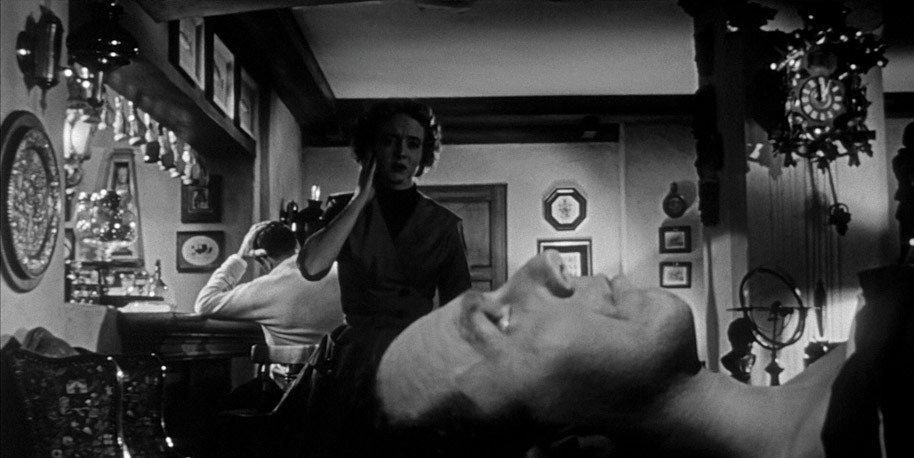
It’s post World War Two and America was thriving. A doctor in the Californian town of Santa Mira returns home after attending a medical convention to find a number of townsfolk reporting that their loved ones are ‘not’ their loved ones. Each reports that the changed person looks like, sounds like and has the memories of the original person except for their emotion, that spark some might call humanity. Brushed aside by the town’s psychiatrist as a contagious mass delusion, Dr. Miles Bennell begins to piece the jigsaw together. While desperately trying to re-ignite a romance with fellow divorcée Becky Driscoll, he gets a call from a friend who asks him to stop sipping that Martini and come over to his house urgently. At Jack and Teddy (Theodora) Bellicec’s home, Miles finds a body laid out on the pool table. Examining it, he finds it unformed, indistinct and alarmingly, the corpse (if indeed it is a corpse) has no fingerprints. The four retire to Jack’s home-based bar where his wife Teddy suggests the body has a resemblance to her husband whereupon Jack slices the palm of his hand open in shock. Miles and Becky leave asking his friends to keep an eye on the body…
In a scene that surprisingly rattled me late last night (how many times have I seen this movie?), Teddy wakes first at the bar while her husband dozes on. In the foreground is the head of the body that slowly opens its eyes. As Teddy realises she is staring down at a duplicate of her husband, its left hand twitches, now scarred with the same bloody cut Jack sustained earlier. I have a vivid imagination and I am fairly reasonable given most situations but this scene and the whole loss-of-identity aspect of this film chills me in some subtle and not so subtle ways. I am working away from home and for ten minutes in the moonlight I kept my eye on the loft space visible from my bed, strongly tempted just to check there were no seed pods lying in wait as I lay in wait myself, marking time for me to wake up a new man while the old one slipped into dust and non-existence. Put that way, does horror get anymore psychologically terrifying? Miles and Becky, two of those who now know what is going on in their small town with just a few details to fill in, run for their lives not daring to sleep… They get you in your sleep…
Director Don Siegel was probably best known for his films with Clint Eastwood, notably Dirty Harry. Astoundingly, he edited the opening montage of some modest Hollywood picture called Casablanca and was a sort of mentor to, of all people, Sam Pekinpah. The Wild Bunch director himself is the meter man in Miles’ basement (as far as we know, not a pod until later in the story). Siegel is about as clean and unostentatious as a director can get. He serves the story and by luck or traditional storytelling talent, he ended up with an evergreen movie, the like of which outlasted him (there have been three sequels slash remakes) and the adult theme of the narrative and intelligence of the characters is something of a first for this genre. Dare I say this is an ‘adult’ film? Siegel is well served by a relatively unknown cast including leading man Kevin McCarthy (with more than a taste of irony given the film’s oft-repeated subtext allied with his surname). McCarthy is solid, respectable and driven to the edge of madness by the reality and horrific situation in which he finds himself. His leading lady is Dana Wynter, and it’s the English theatrical actress’ first Hollywood film role. She is - and there really is no easy way to say this in these days of ultra-sensitivity – absolutely gorgeous. Beauty in Hollywood is not rare but her character is written as independent and intelligent and she plays the role superbly. I can never forget the dress we see her in at the start of the film. It’s a patterned strapless number with a line of what looks like a silk explosion covering her upper chest. She looks like a gingham Guinness in a curvy cocktail glass and I have never forgotten it. Still Wynters run deep…
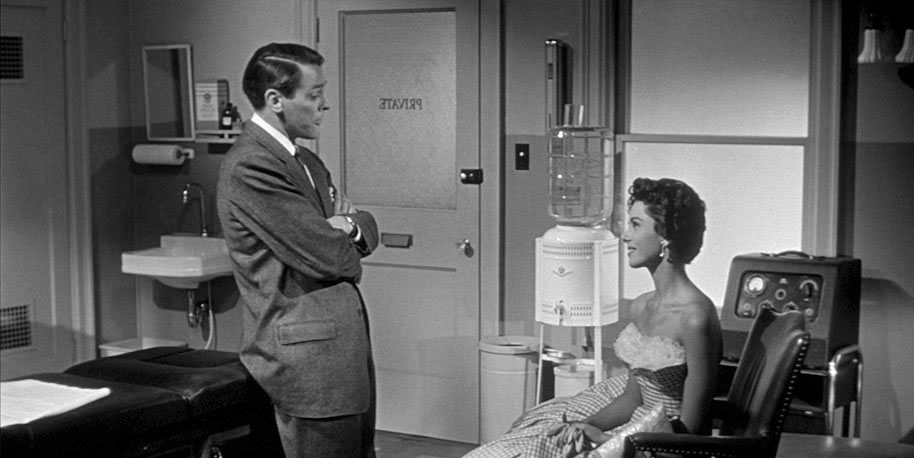
The rest of the cast play their roles with quiet dignity and small town folksiness. A big shout out to Jack and Teddy played by King Donovan and Carolyn Jones whose relationship with Miles is one of great affection and respect. But who knows how anyone would react to a duplicate of their husband growing on a pool table? That way madness (and Jack’s pod-self) lies. Those relied upon to be pod people are scary enough acting as a hive mind. When we see a wide shot of the town square as the pod people distribute more actual pods, there’s a lovely ‘error’ which I suspect the filmmakers could do little to avoid. Imagine being asked as a ten year-old to be in a movie and your sister and her best friend can be in it too. It’s a wide shot and you have been briefed that you are playing an emotionless alien who would not indulge him/herself in an energetic run. So what do you do? You’re children. You energetically run, un-pod like to the centre of the square with more than a little excitement. “We’re in a movie!” Remember, children in the film are more acutely aware that their loved ones have been taken over and replaced by soulless replicas so these kids have to be pod kids.
Aside from the adult characters’ believability, sexual chemistry and easy going charm (the romance between Miles and Becky has not dated one bit), there are moments of humour that the studio didn’t manage to excise - see the Joe Dante commentary for more info on that aspect. My favourite must have been very racy for 1956. It’s in the scene where Miles and Becky enter the cocktail bar. Miles is making his feelings very well-known while Becky is gently demurring. She says “Is this an example of your bedside manner?” to which Miles replies “That comes later…” That, ladies and gentlemen, was practically pornographic in the 50s. And I don’t mean the ejaculation synonym which I’m sure only odd-minded and word-sensitive folk like myself are always attuned to. Carmen Dragon’s orchestral score offers another meaning of the word bombastic and that’s a compliment. It’s strident, brassy and propulsive and underlines the terror from the word go. IBS has picked up sub-textural theories like my collies pick up burrs. Let’s quietly dispense with what this movie has garnered a reputation for, one I would normally celebrate with hosannahs aplenty.
The pod people have been taken as metaphors for soulless Communists who in 50s America represented a threat, one inflated to be infinitely more frightening by the US government with no more enemies on the immediate horizon with which to keep the population fearful. The other subtext ladled on this movie is that of McCarthyism (with the pods representing those who would stifle personal and creative drives in the name of political affiliation). In short, Commies are really scary… Really? Well, writer, producer and director have dismissed these readings, hands in air, stating that the film is simply a no nonsense thriller. Well, it’s the audience that gets to interpret a work anyway it chooses but strip all the historically barnacled subtext away and what you have left is a superior and effective study in justified paranoia with a lot of social commentary and that’s more than enough for me. And thanks to my umpteenth viewing and the writing of this review, I think I understand just what it is that I love about this film. Forgive the following autobiographical paragraph.
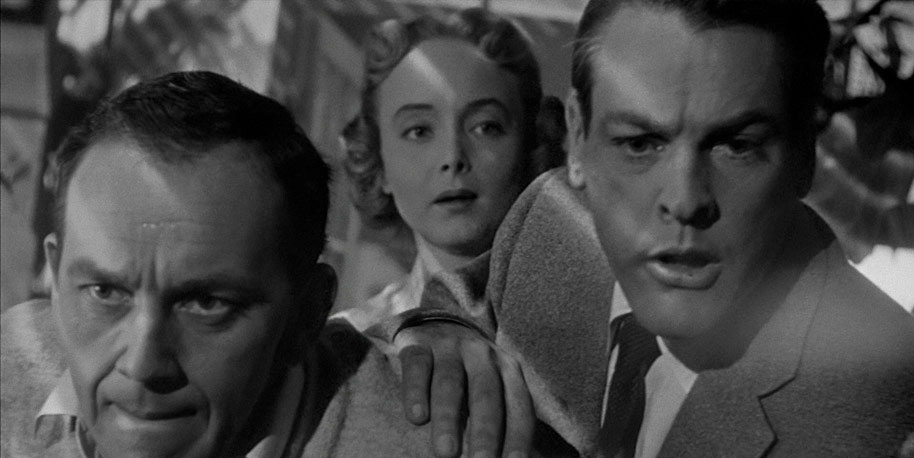
As a child, I adored America and had every chance to do so via what’s known as ‘soft power’, cultural exports like movies and TV. I had an American pen pal before I reached double figures (a pen pal to those unfamiliar with the term is someone you wrote letters to on paper which came from trees – “Duh…” for those older than 25 - usually handwritten in the ancient days of the late 1960s). I bought and swallowed the ‘can do’ attitude and the faux-comfortable diverse-averse societies (normal for the 50s) being illustrated just so by films like IBS. This was Norman Rockwell’s home town, all comfort and reassurance. The fictitious Santa Mira was Perfectville in that everyone knew everyone else and everyone else’s business and it’s no coincidence that one of the lyrics of the sit-com Cheers states “Where everybody knows your name…” This inclusivity was tremendously important to me then and now. I mean, despite the death defying danger on a weekly basis, who wouldn’t want to be part of Buffy’s Scooby Gang? I used to build model towns with cereal boxes and was fascinated how such towns worked in the US. What IBS did was present my fantasy in every detail but like the invaders, the town itself was false, created from many other towns but the illusion was specific and very personal to me. To have the film and the town’s normality then be quietly invaded by extraterrestrial forces did more damage than it would have if I had not been such a fan of the good old US of A. The pod people spat on my comforting fantasy and this is probably why it still messes with my head so sublimely. Of course, like any relationship, my own with America has changed (how could it not have?) but I still harbour wistful thoughts of what America might have been if it had fulfilled the tiniest per cent of its constitutional potential.
The film is based on a serial story first published in Collier’s magazine, a general interest publication that lasted sixty-nine years shutting its printing presses in 1957. The Body Snatchers was subsequently republished as a novel. As a ‘trashy’ science fiction tale, it’s very well written and very memorable. Some have blasted the ending of the story (one unused in all versions of the tale in movie form) but then there’s an argument to say that the tacked on opening and closing scene of the 1956 film is a cop-out artistically. Siegel hated the idea of it but directed the scenes nonetheless not wanting anyone else to screw up his film. You’ll know the scenes when you see them. In the novel, there is a moment before Dr. Bennell describes the pod people making despicable parodies of the humans they’ve encountered when he conjures up a memory to try and understand where he’s experienced that profound hatred before and it’s again a scene that’s stayed with me, not once being filmed in any version of the story. A shoe-shiner (described in the novel as ‘a middle-aged black man’) finally cracks after decades of placing himself literally and metaphorically ‘below’ the people whose shoes he shines. In a breakdown of sorts, his frustration and hurt come tumbling out. For those sensitive to racism, this quote may be problematic but it serves as a memory of the lead character, comparing hatred and self-loathing with the indifference of the pod people towards humanity.
“I just love those shoes, Colonel,” he continued in a suddenly vicious, jeering imitation of his familiar patter. The pent-up bitterness of years tainted every word and syllable he spoke. And then, for a full minute perhaps, standing there on a sidewalk of the slum he lived in, Billy went on with this quietly hysterical parody of himself, his friend occasionally murmuring, “Relax, Bill. Come on, now; take it easy.” But Billy continued, and never before in my life had I heard such ugly, bitter, and vicious contempt in a voice, contempt for the people taken in by his daily antics, but even more for himself, the man who supplied the servility they bought from him.”
That kind of scene stays with you, as does the movie, a quietly brilliant slice of American science fiction paranoia. My official copy of the Blu-ray is on order and I suggest you decide to do the same but don’t sleep on it…
Shot in full frame 1.37:1 35mm, the film was then letterboxed to a 2:1 aspect ratio named ‘Superscope’. The widescreen effect was achieved without anamorphic lenses which squeezed the recorded image on to all available space and unsqueezed the projected print, a process which was more expensive. But there’s always a trade-off. The 35mm frame has a finite amount of light sensitive silver halides. Imagine an analogue recording format with a mere 352mm2 of available emulsion. It’s always been a miracle to me how a source that small can create a high definition image thrown on to a big screen. After any optical intervention in IBS, the black and white image loses quality - principally a loss of sharpness - and increases grain. In the police car stock footage, this is most evident. But when we get pure close ups with no optical intervention or degradation, the sharpness and dynamism of the original image is outstanding. Personally, the contrast could have been turned up half a notch but when Siegel wants black and shadow in the frame, he more than achieves his goal.

The original ‘Perspecta’** stereo soundtrack (another short-lived 50s fad perhaps?) has not survived but my technical details are still saying the audio is in stereo. On the cover it states PCM Mono Audio – so we’ll go with that. It sounds pretty decent for a film (what’s the phrase?) ‘of this vintage’ and there’s no dialogue that you can’t make out.
There are new and improved subtitles for the deaf and hard-of-hearing.
** https://en.wikipedia.org/wiki/Perspecta
Newly recorded audio commentary by filmmaker and critic Jim Hemphill (2021)
Hemphill’s commentary represents the flipside of the 50th anniversary commentary by director Joe Dante and the two leads Kevin McCarthy and Dana Wynter. There is some repetition of the facts in both commentaries but this one is the treasure trove of information on the film, its context, its origins and anything you may have always wanted to know about the movie. I like the fact he namechecks the sexual aspect between the adults given the restrictive Production Code was still in place. To say that Hemphill has done his research is to state the startlingly obvious. There are very few gaps to let the movie’s sound cut in while Hemphill takes a breath. It’s sad to hear that Dante’s both commentary guests from 2006 have passed on (Wynter was 79 and McCarthy, 96). There’s a lovely insight at just past the hour mark that despite the compromise of the presentation (pan and scanned TV showings of a film whose quality was already compromised by the technical aspect of shooting in Superscope) there is something ineffable about great movies that can transcend their technical limitations. He mentions the widescreen VHS! Oh, for that, a five star commentary judgement!
50th anniversary commentary with stars Dana Wynter and Kevin McCarthy, and Gremlins director Joe Dante (2006)
A fine combination of commentators with Dante hosting. It’s mostly scene specific and there are lovely character moments. It’s clear that McCarthy still holds a torch for his co-star. As Wynter brushes off the hyperbole of the advertising introducing her as ‘the sensational star discovery’, stating that “They can say anything they want…” McCarthy jumps in, so obviously smitten saying “Yes, they can say anything they want as long as it’s…” and he’s cut off with everyone jumping in at once. Pretty sure he wanted to end his sentence with the word “true.” Sweet. Surprising to hear that ad libs were encouraged (especially humourous ones) by director Don Siegel but frowned upon and largely edited out by the studio. McCarthy’s faux vanity is always fun. Another metaphor I’d not considered was the idea of conformity and how the advertising industry (the hidden persuaders) tried to make everyone smoke the same cigarette, wash with the same soap etc. McCarthy tries and fails to show off his only remaining humourous ad-lib (as mentioned in the review… “That comes later…”) and reveals his Shakespearean start in the acting trade. Wynter mentions how so many directors started as film editors, a fact that Dante enthusiastically supports. You’ll get no argument from me on that score. Dante points out the police car stock footage (having to be blown up to fill the ‘Superscope’ 2:1 frame) and shocks the leading players with the actual production budget figure. Wynter is very funny, self-effacing and charming… “You said, “Don’t have anything for lunch, I have to carry you later…”” Dante wraps up saying “80 minutes of fun.”
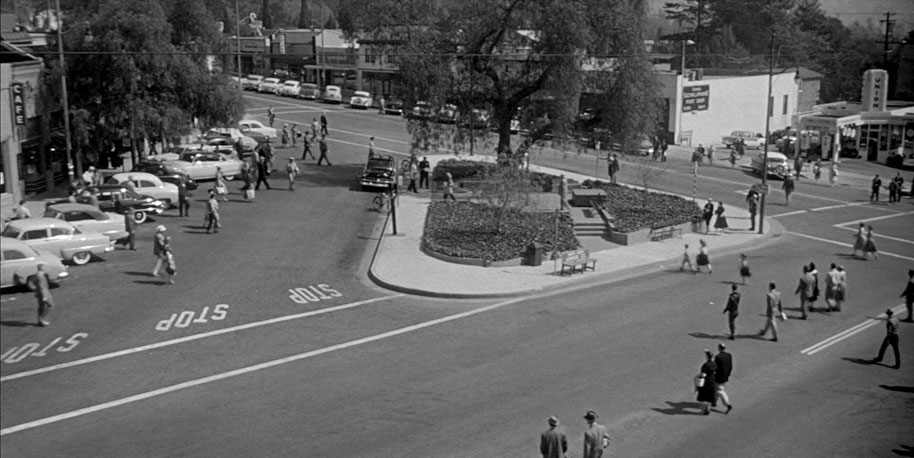
John Player Lecture: Don Siegel (1973): Don Siegel looks over his career with Barry Norman (1 hour, 14’ 40”)
Nice to hear Barry Norman, the voice of film appreciation in my youth interviewing a favourite director. There’s a caveat in the booklet that says the audience’s questions are always off mic and inaudible but this is no problem as Norman paraphrases each one as we go along. Siegel talks about using humour to dissipate tension and his seven year stretch cutting montages for other people’s films. His two shorts garnered Academy awards which kickstarted his directorial career. Siegel covers the idiocy of the studio that took out the humour from IBS as well as tacking on the parentheses scenes and adding a voice over. He reveals that The Beguiled was a favourite of his and its failure hurt. Siegel is a realist and understands the business part of ‘showbusiness’. He self identifies as a ‘hack’ director which Norman immediately undercuts. Siegel’s villains are appraised as being more interesting than his heroes. He talks about encouraging Clint Eastwood’s directing ambitions revealing that two hundred hours of the TV show Rawhide taught Eastwood a lot of technical information. Taking a pot shot at auteur directors, Siegel talks about setting up a ‘Clint’ shot while he tries to top it with a ‘Sigelini’ shot. His choice of favoured directors runs to Norman Jewison, John Schlesinger and John Cassavetes. Siegel shares his love for David Lean’s Brief Encounter (he’s not alone) and he also underlines a point I’ve made many times; namely, the director does not necessarily share the morality of the characters in his movies. The whole idea is absurd and how it got any traction is beyond me (critics taking pot shots at filmmakers maybe?)
Sleep No More: Invasion of the Body Snatchers Revisited (2006): a look at Body Snatchers’ production history. Includes clips from interviews with Kevin McCarthy, Dana Wynter, John Landis, Mick Garris (Sleepwalkers), and science fiction historian Bob Burns (26’ 34”)
Both leads McCarthy and Wynter (in 2006) as well as historians and writers with filmmakers Mick Garris and John Landis pour their love and appreciation into the movie. 50s censorship wanted ridiculous changes (divorce was a no-no in Hollywood). There are some great behind the scenes photography including the efforts of the effects people to make moulds of the cast and of the actual shoot. I still marvel at the size of the arc lights needed even on bright sunny days. It’s also nice to see Buckaroo Banzai writer W. D. Richter weighing in on the film and making the great point that the ‘happy’ ending may not be as happy as assumed. The studio even wrote an intro and coda to be delivered by Orson Welles.
The Fear and the Fiction: The Body Snatchers Phenomenon (2006) considering the film’s themes and critical interpretations (8’ 19”)
What a great extra not just for the insights of the participants (Director John Landis’ quote that what Americans fear most is outside ideas is a doozy) but for its editorial playfulness. Semi-subliminal textual commands are edited in culminating in a scene not out of place in John Carpenter’s They Live… Obey! Indeed.
What's In a Name? (2006): a short video piece about the title of Invasion of the Body Snatchers and some of the changes that were made to get it right (02’ 16”)
A lovely extra on the battle for the right title. The sophisticated and classy Sleep No More, star McCarthy’s suggestion championed by director Siegel, was thrown out by the studio. After many other – and some ridiculous – suggestions, finally someone suggested tacking Invasion of on to the story’s published title and a classic was born.

Return to Santa Mira (2006): a look at the locations where key segments from Invasion of the Body Snatchers were shot (12’ 44”)
This is a bit of fun, breaking down where all the locations actually were and what was and wasn’t shot in a set on a soundstage. Adding to the idiosyncrasy of this extra is a humourously scripted (OK, cheesy) commentary that comes across like a 50s commercial. It makes something of a mockery of the frightening images taken from the movie (which the ridiculously cheerful music enforces).
Original theatrical trailer (2’ 15”)
Scratched and somewhat overexposed, this trailer does provide the true cineaste with the proof of the quality-con that is ‘Superscope’. Seeing the entire frame with all the detail above and below the non-anamorphic letterboxing shows you that to create a wider screen, you use a smaller area of original negative and therefore the quality by definition must suffer. Interesting to see a bespoke trailer intro while McCarthy is struggling at the hospital to warn us all about the menace that took over his town. I also quite liked the phrase ‘Vortex of terror!’ It is extraordinary what was deemed to work in film marketing in the 50s.
Trailers From Hell: Invasion of the Body Snatchers (2013): Body Snatchers fan Joe Dante celebrates the film (2’ 47”)
I’ve yet to see a more fulsome, luxuriant set of hair on anyone than the wavy nest that sits on Joe Dante’s head. Marvellous! Clearly a big fan, he gives us a bit of background on some studio decisions and the trailer now in 16:9 has clearly been sourced from a video original. It’s not quite as dirty or washed out than the trailer that precedes it
Gallery
This consists of two colour posters featuring Kevin McCarthy pulling Dana Wynter (who incidentally has the wrong dress on in this scene but someone with my own sensibilities chose ‘that’ dress as the most eye-catching), ten front of house black and white stills, forty-one behind the scene stills including some of the full-body mould taking and a number of both leads clowning around for the camera.
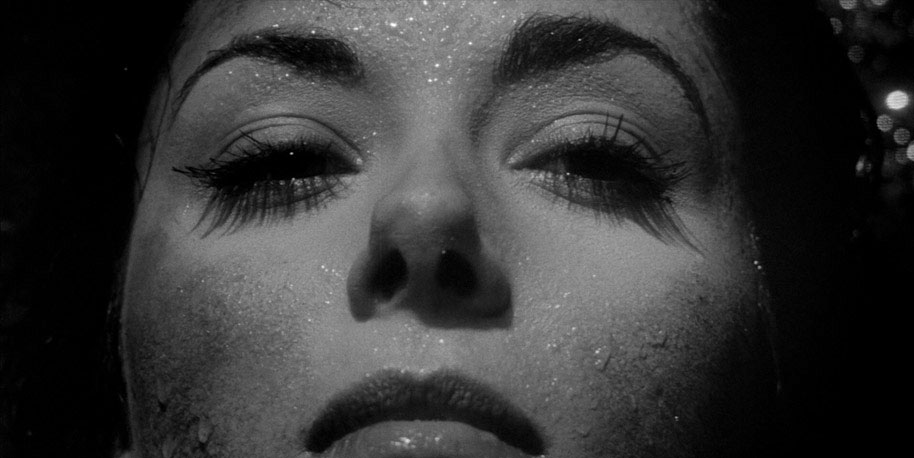
A selection of complementary archive films, with British propaganda short Doorstep to Communism (1948) and groundbreaking botanical cinematography in Magic Myxies (Mary Field, F Percy Smith, 1931) and Battle of the Plants (F Percy Smith, 1926)
Now this is what I call inventive programming. “What can we add to bolster the extras on our disc featuring a classic US movie about pod-based extraterrestrial spores that may or may not be a critique of Communism?” asks the BFI team. How about a short Conservative party political about the dangers of the ‘red menace’ from 1948. Add to that, let’s offer up a slime fungus short – almost relevant - and finally a short that shows us the wars plants wage for dominance (and here’s the surreal part) in the hedgerows of England. Someone link that up with Santa Mira, California. In a small but eyebrow raising way, I’m really looking forward to these odd bedfellows:
Doorstep to Communism (11’ 19”)
“We don’t want that sort of thing here!” Oh, this is a hoot. In showing the totalitarian excesses of Stalinism, the argument goes that Socialism is the doorstep (cut to a doorstep) or the running board (cut to a car’s running board) to Communism. The only answer to the Communist menace is Conservatism. It’s politics for three year-olds with added simplistic and deeply patronising animation.
Magic Myxies (10’ 30”)
“Notice how it quivers with delight after a good meal.” Stunning! I have no idea how the film lens technology of 1931 could possibly have shot this. It’s not animation. It’s time-lapse but of extremely small and frankly extraordinary life. This exact and highfalutin ‘received pronunciation’ of the narrator is a constant joy as it anthropomorphically compares all of this microscopic shenanigans with human behaviour. It’s utterly bonkers but not exactly pod-like.
The Battle of the Plants (10’ 20”)
Oh goodness, a second hoot. The score to this garden plant movie is horror-movie central casting***. Is that a theremin? And I’m only seconds in. I can’t tell you how things are going to work out but if you are going to dissolve from one text card to another, be aware of complete illegibility over the mix. OK, where now? Ah, black velvet studio timelapses. Revolutionary for its time (1926) but a little redundant nowadays after Attenborough’s series The Secret Life Of Plants.
*** Aha! I thought the quality of the score could not have originated in the 20s. It’s from my music library of choice, Audio Network.
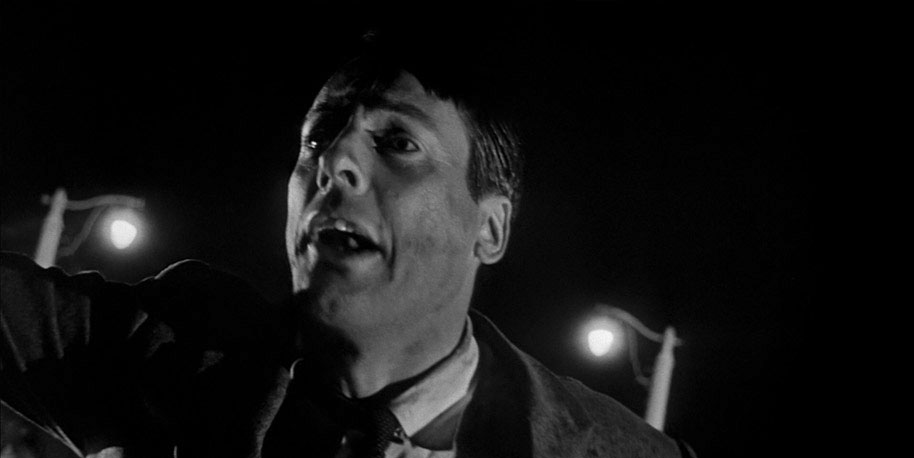
An illustrated 40 page booklet with new writing by Dr Deborah Allison, Charlie Bligh and Katy McGahan, and an archive piece by J Hoberman
The first thing that grabs your attention is what seems to be a post-coloured collage cover of an insane looking Kevin McCarthy staring wildly down at Dana Wynter in a black dress wrapped in a giant seed pod. I wonder if this was era-based marketing or a BFI design? McCarthy’s photo is actually taken from the scene of him stabbing pods with loaded syringes (hence the nutso expression).
Allison’s The Dark Mirror: Invasion of the Body Snatchers gives us a detailed background on Finney’s original work and how it morphed into the on screen representation. It’s really well researched and offered up a few gems that had not been revealed in the previous sampled extras and that’s always a plus.
J. Hoberman’s Paranoia and the Pods is an examination of the metaphor and similes the pods represent. With such a rich vein to mine, it’s not surprising that critics and academics could tear off a chunk of IBS and chew for hours. A direct comparison with science fiction icon Robert Heinlein’s The Puppet Masters (one hell of a read if a little dated now about alien slugs that keep individuals in thrall to their commands while attached to their human hosts’ upper spines) is mooted and I’m quite glad to see that the deeply cynical extract from the book I quoted in the review is also ripe for re-examination. The idea that the ETs of Close Encounters of the Third Kind were invaders seems ridiculous to me as is the idea that Raiders of the Lost Ark (for which 1978 IBS remake director Philip Kaufman got a story credit) was soulless is beyond my understanding. The final thought that “Americans may no longer have even that identity to lose,” referencing the fight against Communism is still troubling to me. But hey. A discussion for another time.
Charlie Bligh’s Don Siegel (1912 to 1991) is a terrific and comprehensive look at the director’s work and career.
Writer, filmmaker and curator Katy McGahan provides detailed information about all what McGahan calls ‘Special features’, a four page wealth of detail that I cannot remember seeing the like in other booklets. It’s nice to see the extra features getting that level of attention.
Invasion of the Body Snatchers is a classic for a reason. While its creators may have played down the inherent and bounteous metaphors of emotionless pod people, the film’s themes strike many chords, some inevitably based on individual interpretation. To me, the film illustrates what may be the most scary idea of all… Are we uniquely human or are we merely organic robots marching on some pre-determined pathway before we fall to the inevitable? As I approach the autumn of my own existence, the film’s central theme becomes more pertinent. I, pod? Are you next? Hugely recommended.
|